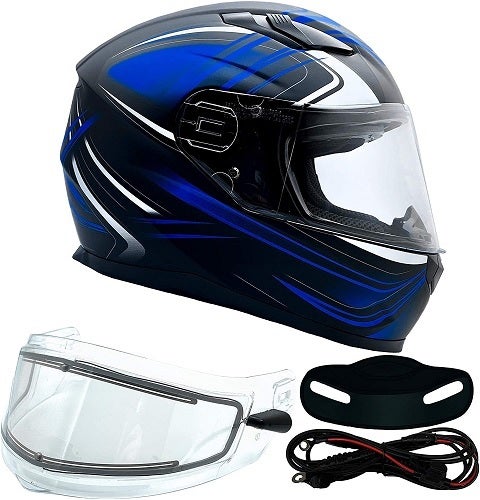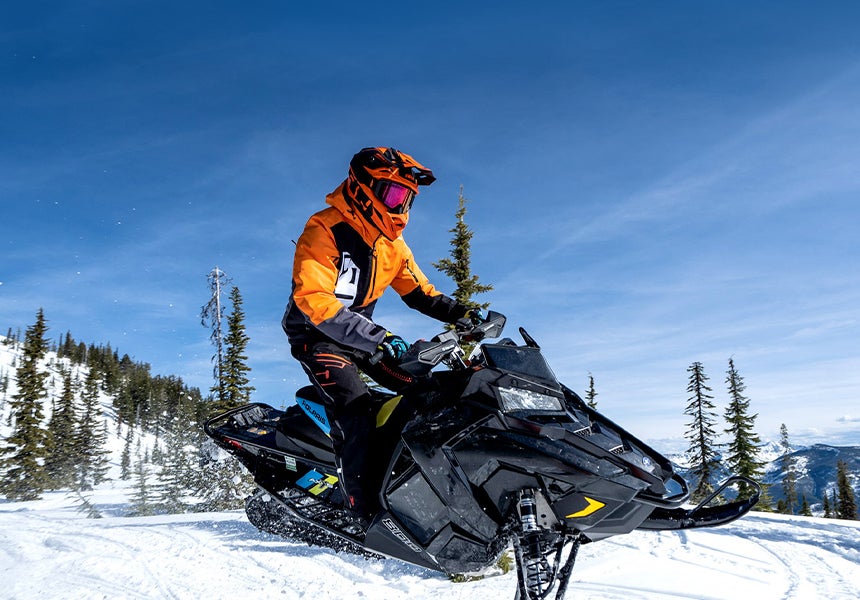
Our Editors independently research, test, and rate what we feel are the best products. We use affiliate links and may receive a small commission on purchases.
There is never a reason to go riding on a snowmobile without a helmet. There are many comfortable, secure and protective helmets available at a wide range of price points these days, so there is no excuse to not wear one. Besides, they often provide protection from the cold as well as from impacts. What makes for the best snowmobile helmets? A blend of fit, function and protective features all combine to give you a better skid lid, and we’ve rounded up a few of the better options for you to help you find the right one for your head. Keep in mind that we want you to have a fun ride, but we also want you to be able to come home at the end of the day. Wearing a helmet is vitally important. so let’s take a look at the best snowmobile helmets available to you.
Best Snowmobile Helmets
For more of our snowmobile gear recommendations, have a look through these popular Outside Pursuits guide links: Snowmobile Goggles, Snowmobile Gloves, Snowmobile Boots.
Quick Answer: The Top Rated Snowmobile Helmets
- 509 Altitude Snowmobile Helmet
- Typhoon K27 Snocross Snowmobile Helmet
- Ski-Doo Modular 3 Snowmobiling Helmet
- Typhoon Snowmobile Helmet w/ Heated Shield
- HJC Dosta Snowmobile Helmet w/ Electric Shield
Snowmobile Helmet Reviews
#1 Editor’s Choice – 509 Altitude Snowmobile Helmet
- Style: Snocross
- Shell: Carbon fiber composite
- Heated Shield: No
- Breath Box: Yes
- Goggles Included: No
The 509 Altitude is a snocross style snowmobile helmet that sports safety ratings from DOT and ECE, so this helmet is sure to meet your safety needs. Being a snocross style, it lacks a visor or lens yet allows the rider to choose their own goggle to pair with the helmet. The visor and blacked-out styling is aggressive and modern, sure to match that new high-horsepower sled! Make sure to look for goggles that are going to fit and feature a nose deflector to push breath away from the lens.
Good vents integrated into the body of the helmet will keep you cool as you ride, and a breath guard is removable for comfort – no matter the riding conditions. Offered in 7 different sizes and 15 colors, this helmet is almost sure to fit your head comfortably in style! The 509 Tactical is my overall top pick for the best snocross-style helmet. It offers the key features you need, along with a quality design.
#2 Runner Up – Typhoon K27 Snocross Snowmobile Helmet
- Style: Snocross
- Shell: Polycarbonate
- Heated Shield: No
- Breath Box: Yes
- Goggles Included: No
This DOT certified, budget-friendly helmet is ideal for the casual snowmobile rider. If you’re trying to keep dollars in your pocket and still keep yourself safe on the sled, this is a great choice. Most helmets cost far more, and you don’t always get a DOT certification. It features a removable breath guard, removable helmet liner plus vents along the back of the helmet. The liner is also removable, so you can easily wash it when you need to. It even comes with an adjustable sun visor and weighs only 3 pounds! These are impressive features to find in a great-value snowmobile helmet.
With a breath box, chin skirt, helmet bag included and an extremely warm liner, this is probably the warmest snowmobile helmet on the market. Its return policy specifies that if a refund is requested, the value will be the price of the helmet minus shipping costs that the seller has incurred.
#3 Best Modular Helmet – Ski-Doo BV2S Modular Snowmobile Helmet
- Style: Modular
- Shell: 100% Polycarbonate
- Heated Shield: No
- Breath Box: Yes
- Goggles Included: No
The Ski-Doo is a DOT-approved helmet in a modular setup and an awesome solution for those looking for a quality modular helmet. Dual visors are a great option for riders looking for a sunglasses or tinted visor solution. An internal flip-down sunshield can be lowered with a single lever operation to protect from sunlight, or improve lighting by removing the dark lens altogether when it’s overcast or starts getting dark. The Ski-Doo features a one-button, glove friendly flip up system converting the helmet from full-face to open-face, plus an easy-to-use quick release buckle system.
With Ski-Doo’s Breath Evac, fogging is a thing of the past. And if you wear glasses, you will appreciate the extra room in the front of the helmet to wear eyeglasses comfortably. The lens of the helmet uses Ski-Doo’s Clear Vision Technology, giving you crystal clear vision that shines in low light conditions. It also includes a 4-year limited warranty to cover you if there are any defects with the helmet, or if you change your mind for any reason.
#4 Best with Heated Shield – Typhoon Snowmobile Helmet with Heated Shield
- Style: Full Face
- Shell: Acrylonitrile Butadiene Styrene
- Heated Shield: Yes
- Breath Box: Yes
- Goggles Included: No
This Typhoon helmet is relatively similar to most other snowmobile helmets, but with one big difference. This helmet is a modular/flip up design with a heated shield! Many snowmobilers like the ability to flip up the helmet for extra convenience. It comes with two lens shields, the installed single pane and one double pane. The lenses have an anti-fog coating on the inside, plus a scratch-resistant coating on the outside. There’s a lot to like about this helmet, and it comes with an adjustable breathbox plus a chin skirt.
The Typhoon is available in the most sizes of any snowmobile helmet I’ve seen, so everyone in your family should be able to find the perfect size for them. The liner in the helmet is both comfortable and removable, so you can wash it as needed. The ventilation system is adjustable for changing weather conditions and meets all DOT safety standards.
#5 Customer’s Choice – HJC Dosta Snowmobile Helmet with Heated Shield
- Style: Full Face
- Shell: Polycarbonate
- Heated Shield: Yes
- Breath Box: No
- Goggles Included: No
HJC is well known for making quality motorcycle helmets, and the Dosta is an excellent adaptation for snowmobilers. Like the Typhoon, it has a heated face shield lens that’s an excellent feature to have for backcountry use, or when it’s snowing or sleeting. The liner is fully removable, can easily be washed and is a comfortable helmet for all day use.
HJC has what they call an “ACS” or Advanced Channeling System, which means you can adjust airflow to your liking, depending on weather conditions. It comes with an adjustable breath guard to prevent fogging, and the shields are easily changed out for when you don’t need the heated one. The injection molded shell is made from polycarbonate for safety, and it meets all DOT standards. I really like that they make the liner removable so it can be washed, overall a great choice for a snowmobile helmet!
How to Choose the Best Snowmobile Helmet for You
Types of Helmets
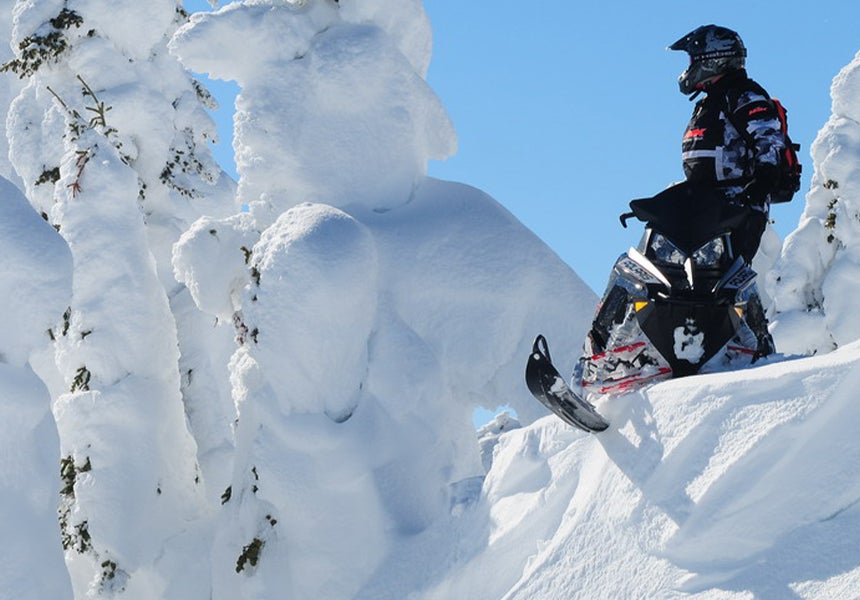
Full Face – Full face helmets feature a completely protected dome with one seamless shell. These are probably the most common type of helmet for any sport across the world. The opposite of full face would be a bowl helmet, like the classic black-spiked, leather jacket, biker-dude helmet that sits high on the head and does almost nothing to protect your head.
Modular or ¾ – Modular helmets are probably the best possible helmet to get your hands on. These helmets feature a jaw which can be locked down for a full-face style, or raised for an open-face setup.
Not only are these customizable, but if you ever get hurt while wearing the helmet, the EMS crews will love you. As a trained EMT, I can tell you that the best helmet to be wearing if you get hurt is one where emergency crews can access your face (airway) without removing the helmet.
Snocross – Snocross helmets are a mix between a dirt bike helmet and a full face snowmobile helmet. These are pretty popular for high-flying adrenaline riders, or anyone who just prefers the style and fit. Use separate goggles with this helmet, allowing for more ventilation and customization. The open face design will ensure your heat, sweat and breath are carried away before being able to fog up your view. Here is a good primer on how to choose a snowmobile helmet by Canada’s Motorcycles:
Lenses
One of the most critical features of snowmobile helmets is anti-fog technology. Waste no money here and go for the top of the line. In cold weather, face shield lenses will want to fog up (and you’re going to be unhappy if this happens). Impact rating, lens material and anti-fog technology really give us a good understanding of the quality of helmets out there. Another critical piece of technology is the dual-pane lens. This is necessary for anti-fog capabilities, and we suggest you avoid any single pane lenses.
There are 3 shields/lens available:
Dual Pane Shield: This is the most common type of lens, and a necessity for a snowmobile helmet. As the name implies, there are 2 lenses which are separated by a thin layer of air that acts as insulation. This keeps condensation from the warm air on your face meeting the cold air outside. It works exactly the same as the dual pane windows on your house.
Heated Shield: Under normal conditions, the dual pane lens works fine in keeping your lens from fogging up. When the temperatures drop low enough or it starts sleeting, the only way to totally prevent fogging is with a heated shield. The electric heated shield has a heating element that runs around the perimeter of the shield and plugs into the sled’s electrical system.
Framed vs. Frameless: This is pretty much an aesthetic choice. It used to be that all dual pane lenses had a frame around the lens to seal them, but advances in lens technology has eliminated this need. The frameless style has a “cleaner look” to some people, but this is really up to you.
Breath Guard
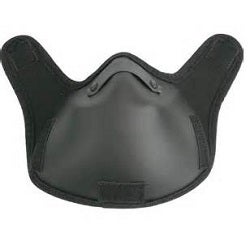
These helmet inserts are adjustable and seal your nose and mouth to ensure that your moist, hot breath doesn’t circulate up and onto the lens. Cold lenses in chilly conditions plus hot breath equals condensation and fogging. The breath guard should seal tightly around your face so it directs your warm breath down and away from the shield, but not so tight that it’s uncomfortable.
A breath guard is usually attached with velcro strips or snaps, and some have a metal strip along the top of the nose for a better seal. For snowmobilers using snocross style helmets, the breath guard also functions as insulation and keeps the cold air away from your skin. A breath guard is an excellent choice and, when paired with a high quality dual pane lens, almost guarantees no fogging!
Ventilation
Ventilation is actually very important, even in those colder conditions. Despite chilly temperatures, these helmets can get hot quickly, especially for the more active and aggressive mountain riders. Airflow through the helmet is critical for heat management, and adjustable vents are a great tool for keeping temperature under control and fog at bay.
Safety Rating
Depending on where you’re living and what you intend to do as a snow sports rider, you may want to seek certain safety ratings.
DOT – or Department of Transportation is a no-brainer certification anyone should be looking for. Don’t even consider a helmet without this rating.
Snell – is an independent rating group with high standards, this rating is a smart buy!
ECE – for European buyers, look for this indicator. The Economic Commission for Europe samples these helmets for quality and standards.
FAQs
What is the best snowmobile helmet to buy?
Our pick for the best helmet that’s currently on the market is our Editor’s Choice, the 509 Altitude Snowmobile Helmet. It comes in a variety of colors and sizes to suit your preferences, and is guaranteed to meet your safety needs.
How often should a snowmobile helmet be replaced?
Helmets, no matter how expensive they are, are designed to be single-use. This means that after any accident that involves a hit to the head, the helmet needs to be replaced, or at the very least, inspected by a qualified safety technician. The interior components break down in an impact and cannot be reused.
It’s recommended to replace or upgrade your snowmobile helmet every 3-5 years, depending on how much wear you get out of it each year. Most manufacturers should offer a warranty that covers this period in case anything goes wrong.
What is the difference between a snowmobile helmet and a motorcycle helmet?
While both helmets are designed to protect you from serious injury in collisions or falls, snowmobile helmets can also protect you from the cold with insulating properties, and often include vents to prevent fogging with dual-pane (double-lens) face shields.
What is a modular helmet and why are they safer?
Modular, or ¾ face helmets, are the ones that are full-face with the standard visor, but they can also be hinged up at the jaw to expose the full face. They’re like all the helmets in one nice package! They allow you to have any configuration of helmet style just by adjusting the helmet that’s already on our head.
From an emergency perspective, modular helmets are ideal for first responders. Should you get into a wreck with your helmet on, they can monitor and access your airway (nose and mouth) without having to remove the helmet. This is actually quite important from their perspective, so a modular helmet is one of the safest you can get.
How do I know my snowmobile helmet size? How tight should a snowmobile helmet fit?
If you’re buying your helmet online for the first time, you should always take measurements of your head size to ensure you’re choosing one with a snug fit. With a measuring tape, wrap it around the circumference of your head, slightly above your eyebrows to determine your helmet size. Most manufacturers will offer measurement ranges from XS to XL, so you can match your measurements to the range it falls in. In general, helmets should feel snug around your head, but not hurt you or cause discomfort in any way. You’ll know if it’s too large if it starts to slip off with slight movements.
Should I use sunglasses or a shaded visor?
For snowmobile riding, you can go about things in a few different ways. One method is the open helmet and goggles strategy, similar to mountain bikers. Another strategy is a full face helmet with sunglasses. Lastly, you could go with a full face helmet and built-in shaded visor. Sunglasses are a great option for those who already own a helmet and can’t change visors. Riding into the sunset or through changing weather conditions can quickly be adapted by adding or removing sunglasses, so the choice is yours.
Should I wear anything underneath my helmet?
I usually recommend a balaclava if you do need anything under the helmet, but this definitely isn’t essential. As the helmet itself is already providing insulation, if you need more neck warmth or something to block the wind, I’d go with a neck warmer or buff. A windproof neck warmer that can be tucked into your snowmobiling jacket can be useful if extra warmth is something you’re looking for.
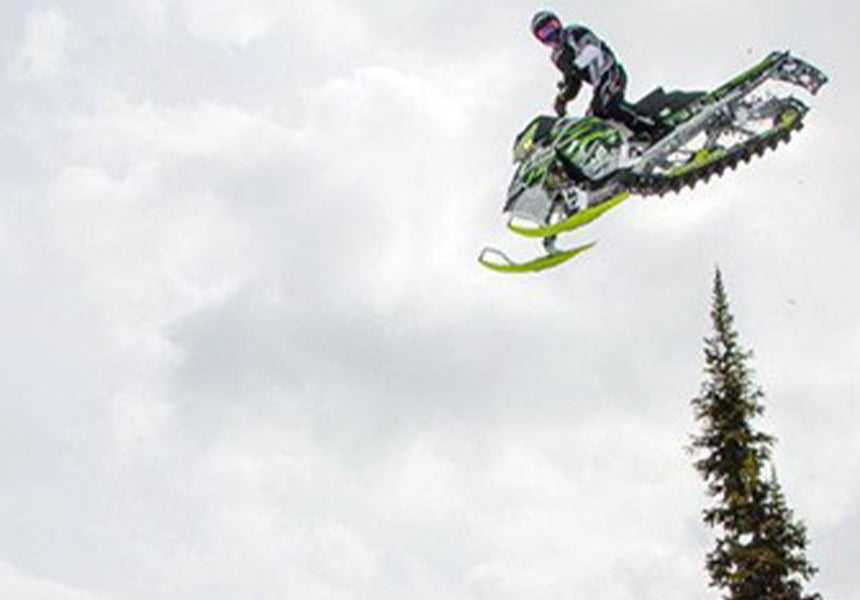
Conclusion
If you’re a hardcore extreme mountain snowmobile enthusiast, you may be on the search for something more high octane. However, for the rest of us who may spend a few days a season on the snowmobile, it’s not necessary to sink a fortune into a good helmet. If you’re into snocross racing, extreme riding or off trail sledding, a MX/Snocross style helmet might be your best bet with the extra visibility this style of helmet offers. Consider what type of helmet works best for your needs and make your decision based on your personal riding style, potential riding conditions etc.
Recent Updates
Nov. 22, 2022: Verified all products for availability. Additional FAQs have been included to address common customer queries.

